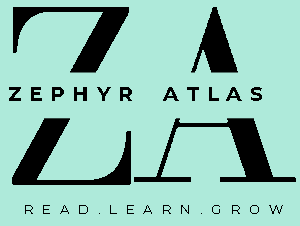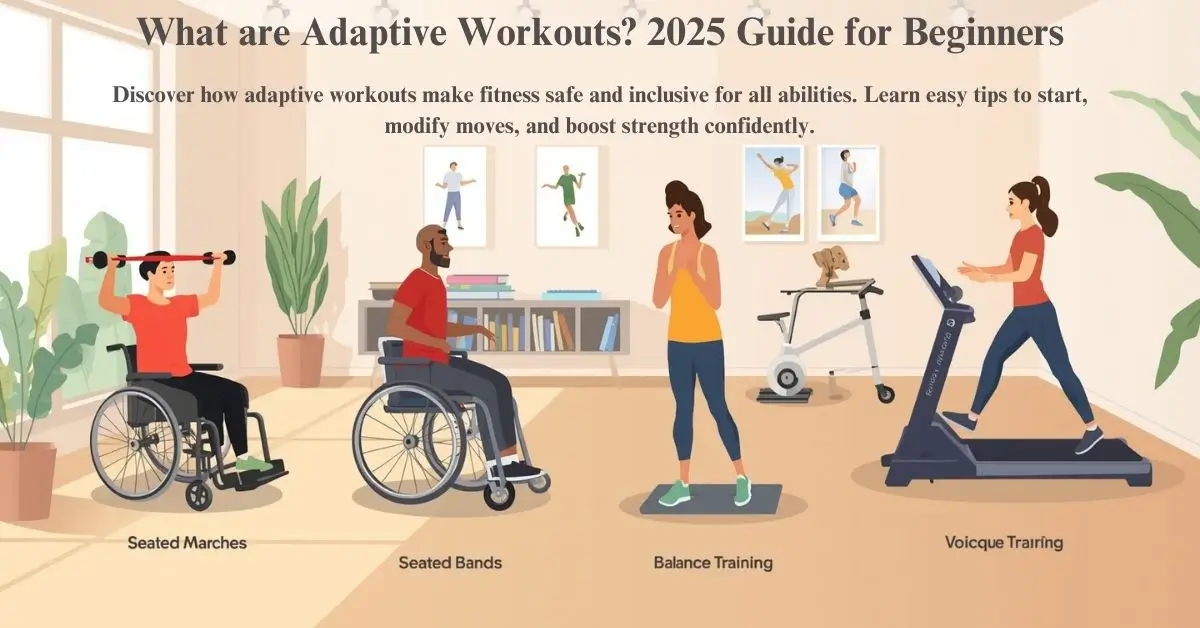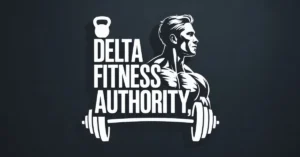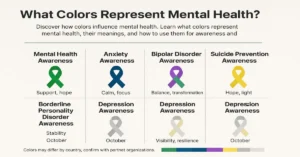Key Intake
Q1: Do I need a doctor’s note to start adaptive workouts?
Medical clearance is strongly recommended, especially after injury, surgery, or long inactivity. It ensures your plan matches your current condition.
Q2: What’s the difference between adaptive workouts and physical therapy?
Physical therapy treats medical issues; adaptive fitness builds long-term function and confidence using similar movement principles.
Q3: Can adaptive workouts help with weight loss?
Yes, by boosting activity and muscle mass, adaptive training improves metabolism even at low impact.
Q4: How often should I do adaptive workouts?
Start with 3 non-consecutive days per week, allowing 48-72 hours for recovery.
Q5: What if I experience pain during exercise?
Stop at once if pain spikes or feels sharp. Mild muscle fatigue is normal; pain is not.
Q6: Are there trainers certified in adaptive fitness?
Yes, look for NFPT Adapted Fitness or ACSM Inclusive Fitness certifications.
Q7: Can adaptive workouts build real muscle?
Absolutely, progressive overload works at every ability level increase reps, resistance, or time gradually.
Table of Contents
Quick Answer
Adaptive workouts are modified fitness programs designed to match your physical abilities, injuries, or limitations through safe movement adjustments, specialized equipment, and progressive routines.
They make exercise accessible, effective, and inclusive for everyone from beginners to seniors in recovery.
Introduction
Fitness shouldn’t have limits. Yet for millions of people with mobility issues, chronic pain, or disabilities, traditional routines feel unsafe or out of reach. Adaptive workouts change that. These programs tailor every movement to your ability level, no shame, no exclusions, just progress. According to the Adaptive Fitness Market Report (2024), inclusive training is projected to reach $6.4 billion by 2033, driven by the global shift toward accessible wellness. Experts from the American Council on Exercise agree: “Adaptation is the new personalization.”
What Are Adaptive Workouts and Who Are They For?
Adaptive workouts modify standard exercises to fit your current strength, flexibility, or mobility. They’re for anyone who struggles with pain, limited motion, or traditional gym intimidation including seniors, office workers, and kids with disabilities.
Core principles:
- Modify movement patterns: seated, supported, or reduced range of motion.
- Use adaptive equipment: resistance bands, chairs, straps, or braces.
- Scale progressively: increase reps, resistance, or duration safely.
In short, adaptive fitness training isn’t “less than.” It’s fitness redesigned for real bodies, not idealized ones.
If you’re a person who is eager to learn about adaptive workouts then I highly recommend watching:
How Do I Start Adaptive Workouts at Home Safely?
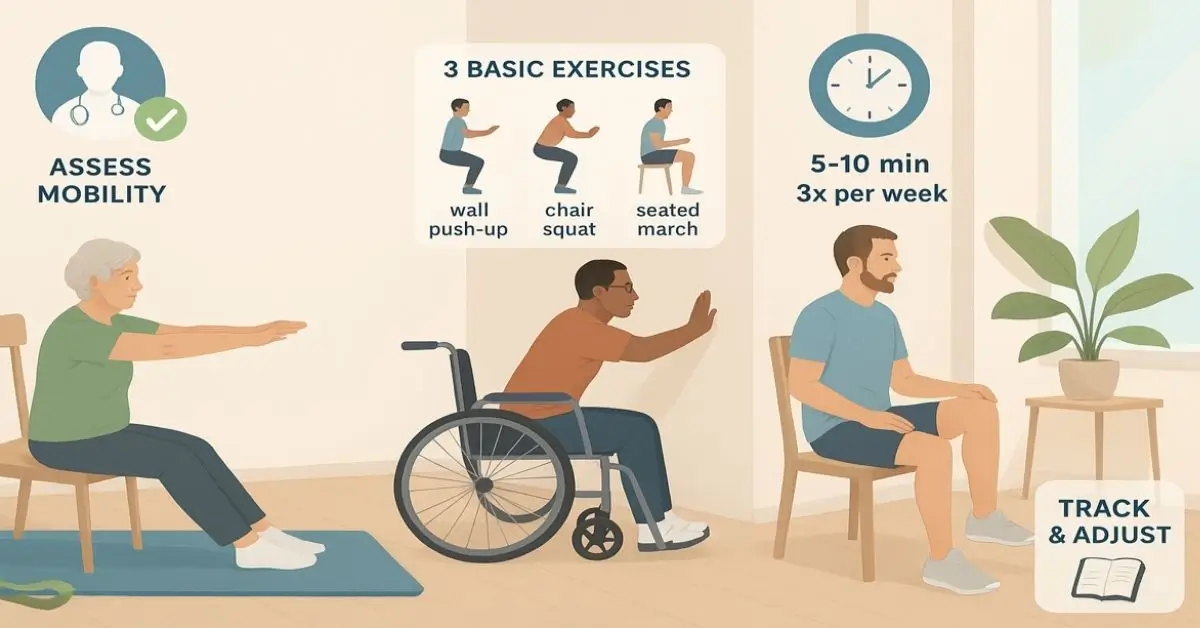
Start simple, think function first, intensity later. Always get medical clearance if you’re recovering from an injury or surgery.
Beginner Safety Checklist:
- Get Clearance, talk to a doctor or therapist first.
- Assess Movement, test mobility and pain tolerance.
- Choose 3 Basic Exercises, like seated marches, wall push-ups, or chair squats.
- Train 5-10 Minutes, 3× Per Week, use an RPE (Rate of Perceived Exertion) of 3-4/10.
- Track & Adjust, record comfort level and range weekly.
This means you’re building strength safely without triggering reinjury. Ever wonder why most people quit? It’s not motivation, it’s skipping these five steps.
What Equipment Do I Need for Adaptive Workouts?

You don’t need expensive gear. The best adaptive workout setups are often low-cost or DIY.
| Equipment Type | Commercial Option | $0 Household Alternative |
| Dumbbells | Neoprene 3 lb weights | Water bottles or soup cans |
| Resistance Bands | Loop or tube bands | Old bike tubes |
| Ankle Weights | Adjustable straps | Backpack filled with books |
| Balance Pads | Stability discs | Folded towel on floor |
| Step Platform | Aerobic stepper | Low, sturdy stool |
This cost-savvy approach removes the biggest barrier which is affordability. With under $50, you can build a home setup that adapts with you not against you.
How Do AI Adaptive Workout Apps Personalize Exercises?
AI-driven adaptive fitness apps like Freeletics or Kaia Health analyze your performance, mobility, and recovery patterns using wearable data. They then auto-adjust workout difficulty in real time, think of it as a digital coach that learns from every rep.
Myth vs. Fact Block
- Myth: AI workout apps are random routine generators.
- Fact: Advanced systems use regression models and neural networks to personalize intensity, rest, and movement sequencing.
The Human-AI Hybrid Model:
True progress happens when you blend AI precision with human empathy. Use AI for daily tracking and a certified adaptive trainer for monthly feedback. That’s the future of fitness, data-smart, not data-blind.
Are There Adaptive Workouts for Seniors with Injuries?
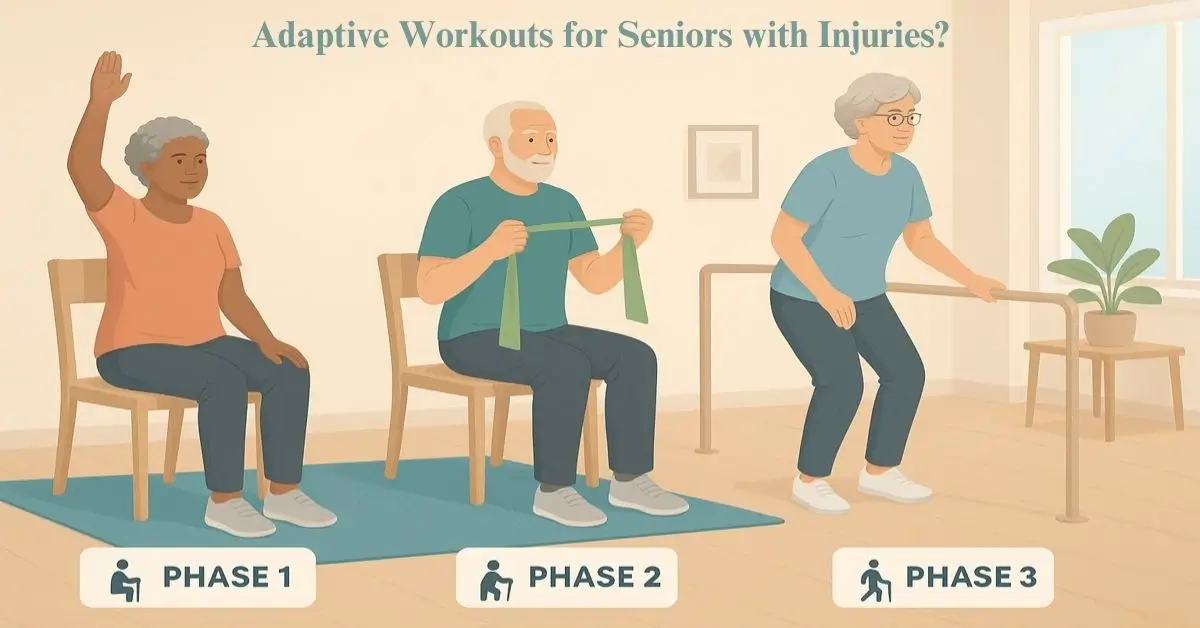
Yes and they’re crucial. Seniors recovering from injuries benefit from phase-based adaptive routines that rebuild strength safely.
3-Phase Recovery Framework
- Phase 1: Gentle seated movement (5–10 minutes, 2× per week).
- Phase 2: Gradual load introduction with resistance bands.
- Phase 3: Controlled functional strengthening (sit-to-stands, supported balance drills).
Use pain scales (0-10) and keep effort below RPE 6. Remember: if it hurts sharply, stop immediately. Adaptive fitness thrives on patience, not pushing.
Can Kids with Disabilities Do Adaptive Workouts?
Absolutely and they love it when it feels like play, not therapy. Adaptive kids’ workouts are built around family-friendly, sensory-safe activities such as:
- Seated ball tosses
- Obstacle courses using pillows and cones
- Adaptive dance or water play
Parents should aim for 15-20 minutes daily, focusing on coordination, not competition. When families join in, consistency skyrockets and confidence follows.
What Are Examples of Adaptive Exercises for Beginners?
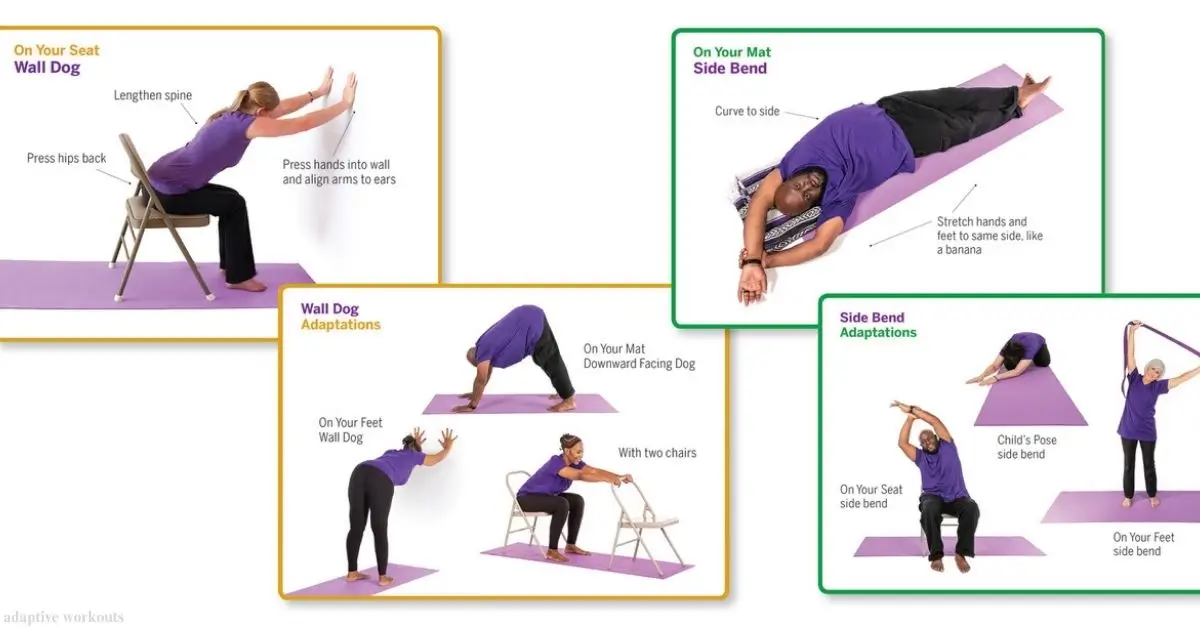
If you can sit, stand, or hold a wall, you can start.
15-Minute Adaptive Circuit (Visual Hook)
- Seated Marches: 1 min (cardio warm-up)
- Chair Squats: 8 reps (lower body)
- Wall Push-Ups: 10 reps (upper body)
- Seated Arm Circles: 30 sec (mobility)
- Repeat × 3 rounds
These simple moves develop strength, confidence, and movement control, no gym required.
Sources
- American College of Sports Medicine (ACSM): 2025 Fitness Trends Report, highlighting inclusive and adaptive training among the top global trends.
- Centers for Disease Control and Prevention (CDC): Increasing Physical Activity among Adults with Disabilities, promoting adaptive fitness as a core public health initiative.
- Athletech News (2025): Adaptive Fitness Platforms Poised for $30.8B Surge by 2035, analysis of the booming adaptive fitness economy.
- ACE Fitness (2024): Expert Insights into Adaptive Training, research spotlight comparing adaptive and traditional resistance training.
- Certify Strong (2025): Explains the adaptive fitness training model and its importance for inclusion and accessibility.
Author Bio
Jordan Myles is an Adaptive Fitness Specialist & Wellness Writer with an experience of 8 years in inclusive training and rehabilitation support. Jordan helps people of all abilities regain strength and confidence through adaptive movement and evidence-based fitness education.
